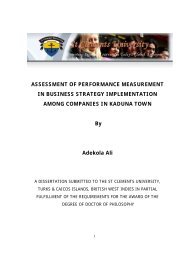The role of informal microfinance institutions in saving
The role of informal microfinance institutions in saving
The role of informal microfinance institutions in saving
You also want an ePaper? Increase the reach of your titles
YUMPU automatically turns print PDFs into web optimized ePapers that Google loves.
areas. However, repayment schedules, tim<strong>in</strong>g <strong>of</strong> loans and other credit contract features<br />
need to be adapted to rural and farm households. But this is noth<strong>in</strong>g new: Current<br />
micr<strong>of</strong><strong>in</strong>ance works to design specific products for certa<strong>in</strong> target clientele groups.<br />
<strong>The</strong> old and exclusive emphasis on farm budgets as a way <strong>of</strong> assess<strong>in</strong>g creditworth<strong>in</strong>ess is<br />
completely outdated, and needs to be replaced by cash-flow analysis <strong>of</strong> the farm household,<br />
consider<strong>in</strong>g all sources <strong>of</strong> <strong>in</strong>come as is practiced <strong>in</strong> micr<strong>of</strong><strong>in</strong>ance. However, farm budgets and<br />
<strong>in</strong>vestment analysis (Gitt<strong>in</strong>ger, 1982) are still relevant and need to be applied <strong>in</strong> larger<br />
<strong>in</strong>vestment projects that demand term f<strong>in</strong>ance as is the case for larger, lump-sum <strong>in</strong>vestments<br />
<strong>in</strong> farm build<strong>in</strong>gs, mach<strong>in</strong>ery, animals, and tree crops. Here, the assessment for farmers must<br />
aga<strong>in</strong> <strong>in</strong>clude their other <strong>in</strong>come sources.<br />
With respect to sav<strong>in</strong>gs, recent books such as Branch and Klaehn (2002) and work<strong>in</strong>g groups<br />
by GTZ and CGAP on sav<strong>in</strong>gs mobilization (Wisniwski and Hann<strong>in</strong>g, 1998) sum up our best<br />
knowledge <strong>in</strong> provision <strong>of</strong> sav<strong>in</strong>gs services. This knowledge is also relevant for servic<strong>in</strong>g <strong>in</strong><br />
provision <strong>of</strong> sav<strong>in</strong>gs services. As <strong>in</strong> the case <strong>of</strong> the lend<strong>in</strong>g bus<strong>in</strong>ess, sav<strong>in</strong>gs need to be<br />
diversified so as to better respond to seasonality and covariance risks when expand<strong>in</strong>g rural<br />
f<strong>in</strong>ance.<br />
Micro-<strong>in</strong>surance is the most difficult <strong>of</strong> three f<strong>in</strong>ancial services; so far, the <strong>in</strong>dustry’s<br />
experience is ma<strong>in</strong>ly with services cover<strong>in</strong>g idiosyncratic risks such as accident, certa<strong>in</strong><br />
illnesses, and death. Aga<strong>in</strong>, pioneers <strong>in</strong> micro-<strong>in</strong>surance consist ma<strong>in</strong>ly <strong>of</strong> non-government<br />
organizations BRAC, and they cont<strong>in</strong>ue to broaden our knowledge. Dror and Preker (2002)<br />
and Churchill et al. (2003) have recently compiled the lessons learned from and the best<br />
practices for micro-<strong>in</strong>surance <strong>in</strong> rural areas.<br />
Informal, but socially and/ or spatially distant lenders frequency tier their loans to<br />
complementary transactions <strong>in</strong> land, labor or commodities as they lack adequate <strong>in</strong>formation<br />
about the creditworth<strong>in</strong>ess <strong>of</strong> the borrower or suitable physical or social collateral. <strong>The</strong><br />
importance feature <strong>of</strong> these types <strong>of</strong> transactions is that the lender also deals with the<br />
borrower <strong>in</strong> a non-lend<strong>in</strong>g capacity and is able to use this position to screen applicants and<br />
enforce contracts at relatively low transactions costs compared to a pure money-lend<strong>in</strong>g<br />
contract.<br />
115
















